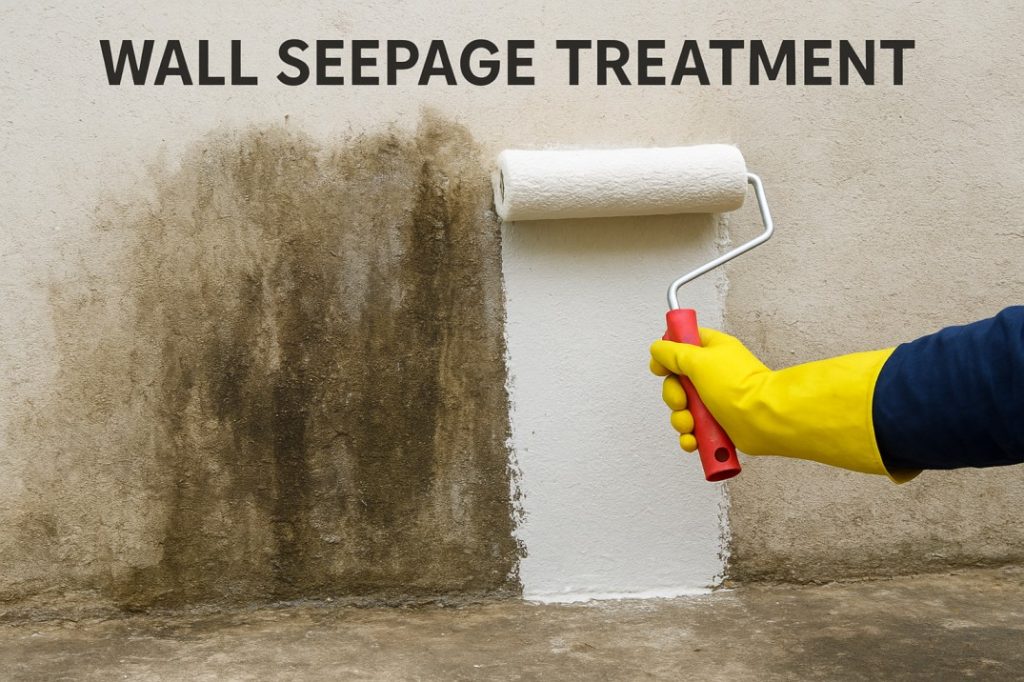
Wall seepage is a common problem in homes, often caused by water intrusion from cracks, leaky pipes, or poor drainage. Left untreated, it can lead to damp patches, peeling paint, mold growth, and even structural damage. Performing effective wall seepage treatment at home not only protects your walls but also improves indoor air quality and prolongs the life of your property. This guide will take you through step-by-step methods to treat wall seepage effectively.
1. Identify the Source of Seepage
The initial phase of treating wall seepage is identifying where the moisture is getting in.
- Inspect for Leaks
Look for leaks in walls, ceilings, taps, pipelines, and water tanks. Even a small leak can cause damp patches over time. - Check Your Drainage System
Check your gutters and downspouts and drainage channels to ensure they are clear of blockages, to divert water away from your foundation and lessen the seepage. - Repair External Damage
Look at your external wall and check for cracks, damaged tiles, or weakened mortar in brick walls, and resolve those issues so that water doesn’t enter your walls.
2. Prepare the Walls for Treatment
Taking the necessary steps will guarantee a successful, long-term treatment.
- Clean the Surface
Remove any loose plaster, dust, debris, or peeling paint you see. A clean wall supports better adhesion and adhesion of sealants and coatings. - Seal Cracks and Gaps
If you notice visible cracks, be sure to fill them with high-quality fillers, cement, or epoxy resin. This keeps water from entering the walls during heavy rains.
3. Apply Waterproofing Solutions
After fix, the next step is to make a wet-proof wall.
- Use Waterproof Coatings
Put on water-resistant paints or solid coatings to the walls that are hurt. These coatings stop water from getting into the surface. - Consider Waterproof Membranes
For bad leaking, put in a rainproof sheet. This laye͏r works as a thick wall to stop water from coming in. - Damp Proof Course (DPC)
For wetness rising, a damp proof course can be added into walls. This wall barrier stops wetness from going up through the wall parts.
4. Prevent Future Seepage
Steps to keep problems from coming back are very important.
- Improve Ventilation
Make air move more with blowers, wall holes, or dampness removers to stop wetness. - Maintain Gutters and Pipes
Clean gutters, drains and pipe͏s often to keep water moving right and stop clogs. - Consider Cavity Walls
For new builds or big remodels, hollow walls work as a good wetness shield; it keeps rooms dry.
5. When to Seek Professional Help
If you are unable to stop the seepage you are experiencing, seeking a professional should be your next step Professionals can:
- Perform a thorough evaluation with moisture meters
- Locate undisclosed avenues of water shedding
- Suggest advanced waterproofing solutions you can trust for a real solution
FAQs About Wall Seepage Treatment
Q1: Can wall seepage be treated at home?
Yes, minor seepage issues can be managed with DIY methods like sealing cracks and applying waterproof coatings.
Q2: How long does a wall seepage treatment last?
With proper treatment and preventive measures, results can last 5–10 years.
Q3: Is it safe to use waterproofing coatings indoors?
Yes, professional-grade waterproofing paints and coatings are safe and non-toxic.
Q4: How can I prevent wall seepage permanently?
Regular maintenance, proper drainage, ventilation, and professional waterproofing for severe issues can prevent recurrence.


